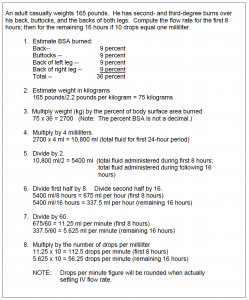Burns result in a loss of body fluid even if there is no observed bleeding.
If 20 percent or more of the casualty’s body is covered with second- and third-degree burns, initiate an intravenous infusion (IV) to help prevent or control hypovolemic shock.
Early signs of hypovolemia in a burn patient indicate internal hemorrhaging or other hemorrhaging. Re-evaluate the casualty for indications of hemorrhage.
a. Keep the casualty flat on his back.
b. Determine the amount of fluid to infuse and the flow rates.
(1) Estimate the casualty’s weight in kilograms (kg). (A casualty’s weight in kilograms can be determined by dividing his weight in pounds by 2.2. Figure 6-5 can be used to convert the casualty’s approximate weight in pounds to kilograms.

(2) Multiply the casualty’s weight (in kilograms) by the percent of body surface area burned (paragraph 6-9).
(3) Multiply the product obtained in step (2) by 4. The resulting figure is the amount of replacement fluid in milliliters (same as cubic centimeters) that should be administered to the casualty over a 24-hour period.
(4) Divide the amount by two. The result is the number of milliliters (ml) which the casualty should receive during the first 8 hours. The remaining amount is administered during the remaining 16 hours.
(5) Divide the quotient obtained in step (4) by 8 to determine the amount of IV fluid to be administered per hour during the first eight hours. Divide the quotient obtained in step (4) by 16 to determine the amount of IV fluid to be administered per hour during the remaining 16-hour period.
(6) Divide the amount per hour by 60 to determine the amount per minute.
(7) Multiply the amount per minute by the number of drops per milliliter (usually 10 drops equal one milliliter) to obtain the number of drops per minute to be administered. This is the flow rate. Note that the flow rate (drops per minute) for the first eight hours is twice as fast as the flow rate (drops per minute) for the last 16 hours.
(8) An example is given in figure 6-6.
c. Select a large peripheral vein for needle insertion.
(1) If possible, initiate the IV in an area which has not been burned. An accessible vein with overlying burned skin can still be used, however.
(2) A vein in an upper extremity is usually preferred over a vein in a lower extremity.
d. Select a large gauge (16 gauge or 18 gauge) needle.
e. Initiate the intravenous infusion using the procedures given in Subcourse MD0553, Intravenous Infusions and Related Tasks. Ringer’s injection lactated (RL) is the preferred replacement fluid. Normal saline (NS) is the second fluid of choice.

